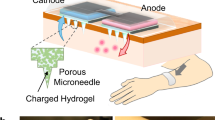Abstract
A novel electrochemical patch is described that works by the hydrolysis of water in a hydrogel between two suitable electrodes that produces a strongly enhanced drug flux through the skin. This non-iontophoretic mechanism requires only a short voltage application (60 s) yet produces enhanced skin permeation over up to 5 h. In this chapter the design and formulation of the patch are reviewed. The results of an in vivo study on humans are also discussed in terms of a comparison with iontophoretic patches.
Similar content being viewed by others
References
Grden M, Lukaszewski M, Jerkiewicz G, Czerwinski A (2008) Electrochemical behaviour of palladium electrode: oxidation, electrodissolution and ionic adsorption. Electrochim Acta 53:7583–7598
Gürten A, Kayakirilmaz K, Yazici B, Erbil M (2003) The primary study on the effects of primer alcohols on the hydrogen evolution reaction on silver electrode. Int J Hydrog Energy 28:1083–1088
Guy R, Delgado-Charro M, Kalia Y (2001) Iontophoretic transport across the skin. Skin Pharmacol Appl Skin Physiol 14:35–40
Hamann C, Vielstich W (2005) Electrochemistry. Wiley-VCH Verlag, Weinheim
Hegemann D, Balazs D (2007) Nanostructured textile surfaces: plasma deposition shows several advantages. NanoS 1:36–41
Jewell L, Davis B (2006) Review of absorption and adsorption in the hydrogen-palladium system. Appl Catal A Gen 310:1–15
Lehmann K, Heinrich C, Heiss R (1988) Balanced anesthesia and patient-controlled postoperative analgesia with fentanyl: minimum effective concentrations, accumulation and acute tolerance. Acta Anaesthiol Belg 39:11–23
Martin M, Lasia A (2008) Study of the hydrogen absorption in Pd in alkaline solution. Electrochim Acta 53:6317–6322
Murdan S (2003) Electroresponsive drug delivery from hydrogels. J Control Release 92:1–17
Peng P, Sandler A (1999) A review of the use of fentanyl analgesia in the management of acute pain in adults. Anesthesiology 90:576–599
Pfister W (1997) Transdermal and dermal therapeutic systems: current status. In: Ghosh T, Pfister W, Yum S (eds) Transdermal and topical drug delivery systems. Interpharm, Buffalo Grove, pp 33–112
Roy S, Flynn G (1990) Transdermal delivery of narcotic analgesics: pH, anatomical and subject influences on cutaneous permeability of fentanyl and sufentanil. Pharm Res 7:842–847
Sathyan G, Jaskowiak J, Evashenk M, Gupta S (2005) Characterisation of the pharmacokinetics of the fentanyl HCl patient-controlled transdermal system (PCTS): effect of current magnitude and multiple-day dosing and comparison with iv fentanyl administration. Clin Pharmacokinet 44:7–15
Schröder B, Nickel U, Meyer E, Lee G (2012a) Transdermal delivery using a novel electrochemical device, part 1: device design and in vitro release/permeation of fentanyl. J Pharm Sci 101(1):245–255
Schröder B, Nickel U, Meyer E, Lee G (2012b) Transdermal delivery using a novel electrochemical device, part 2: in vivo study in humans. J Pharm Sci 101(6):2262–2268
Scranton A, Rangarajan B, Klier J (1995) Biomedical applications of polyelectrolytes. Adv Poly Sci 122:1–54
Weast R (1985) Handbook of chemistry and physics, 66th edn. CRC Press, Florida, p D–152
Woodhouse A, Mather L (2000) The minimum effective concentration of opioids: a revisitation with patient-controlled analgesia of fentanyl. Reg Anesth Pain Med 25:259–267
Yazici B, Tatli G, Galip H, Erbil M (1995) Investigation of suitable cathodes for the production of hydrogen gas by electrolysis. Int J Hydrog Energy 12:957–965
Author information
Authors and Affiliations
Corresponding author
Editor information
Editors and Affiliations
Rights and permissions
Copyright information
© 2017 Springer-Verlag Berlin Heidelberg
About this chapter
Cite this chapter
Lee, G., Schröder, B., Nickel, U., Meyer, E. (2017). An Electrochemical Transdermal Patch for Permeation Enhancement. In: Dragicevic, N., I. Maibach, H. (eds) Percutaneous Penetration Enhancers Physical Methods in Penetration Enhancement. Springer, Berlin, Heidelberg. https://doi.org/10.1007/978-3-662-53273-7_9
Download citation
DOI: https://doi.org/10.1007/978-3-662-53273-7_9
Published:
Publisher Name: Springer, Berlin, Heidelberg
Print ISBN: 978-3-662-53271-3
Online ISBN: 978-3-662-53273-7
eBook Packages: MedicineMedicine (R0)




